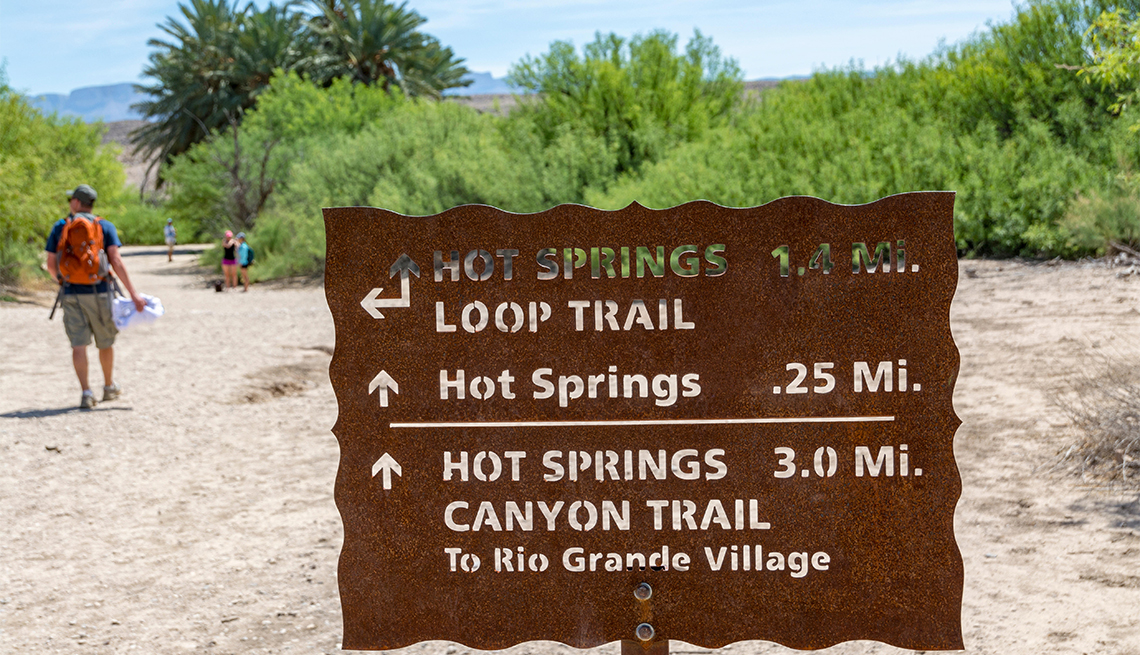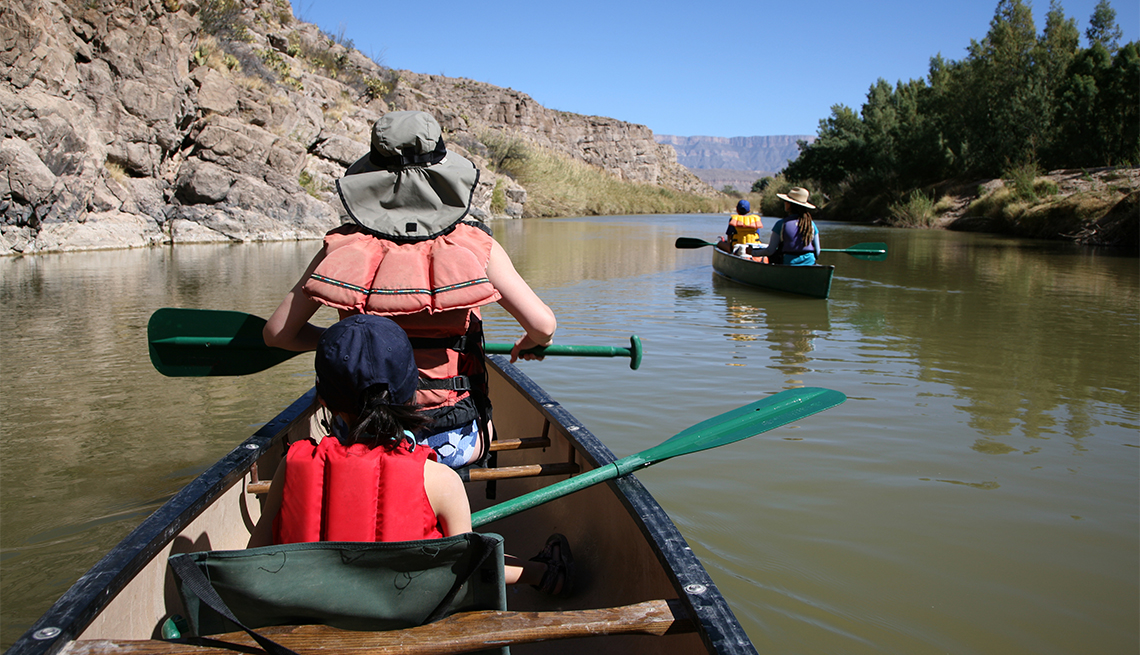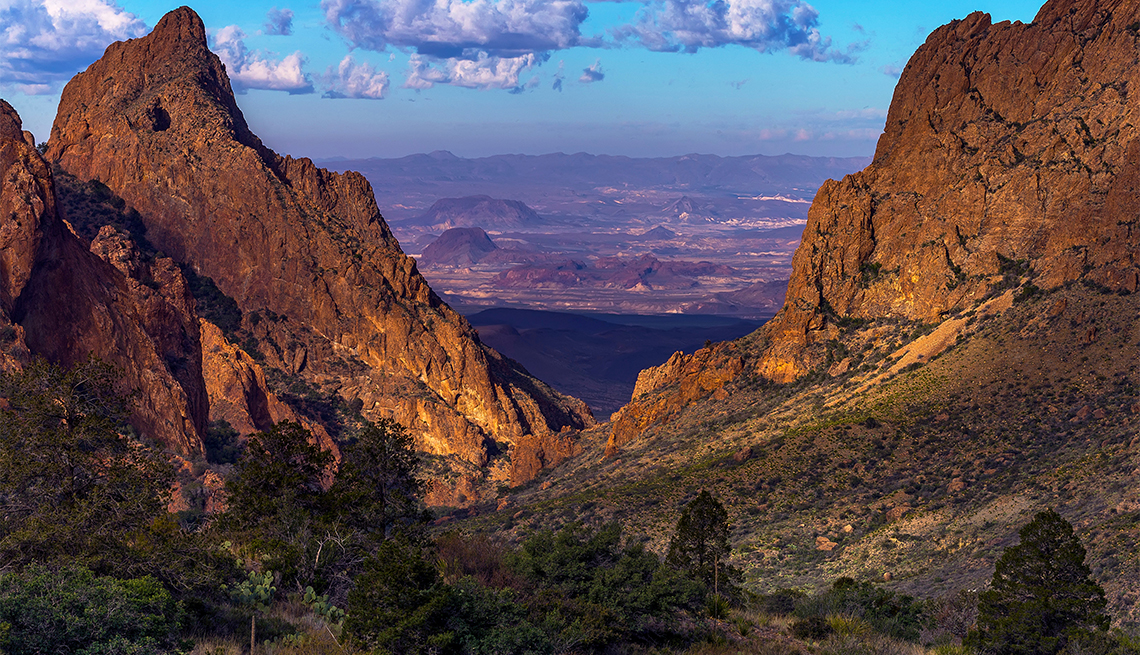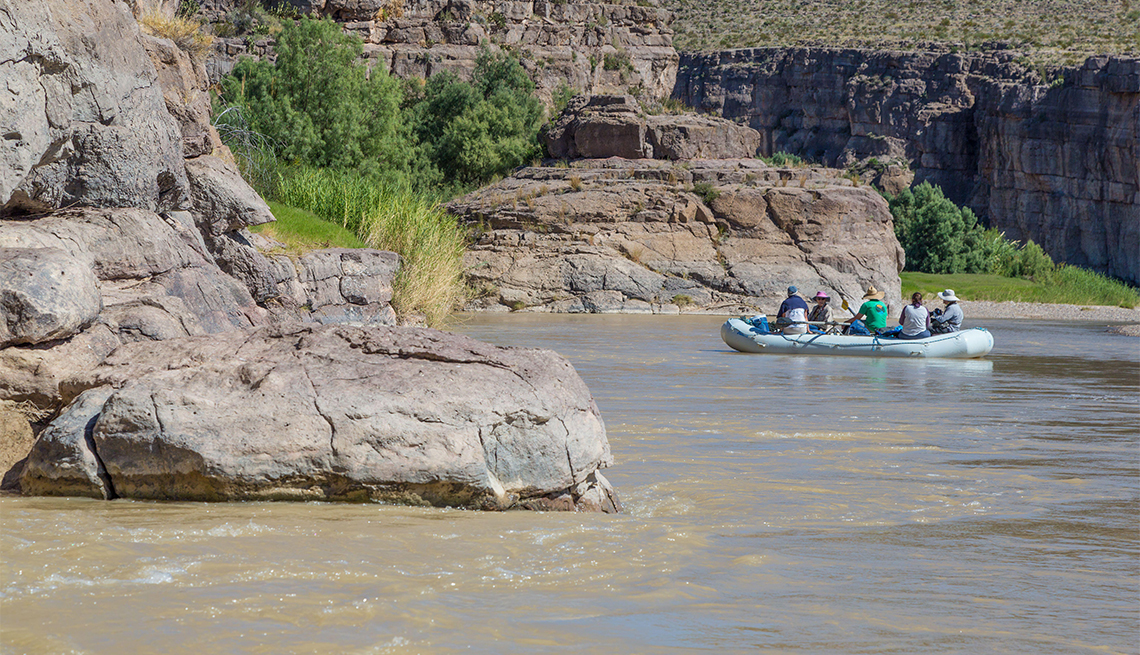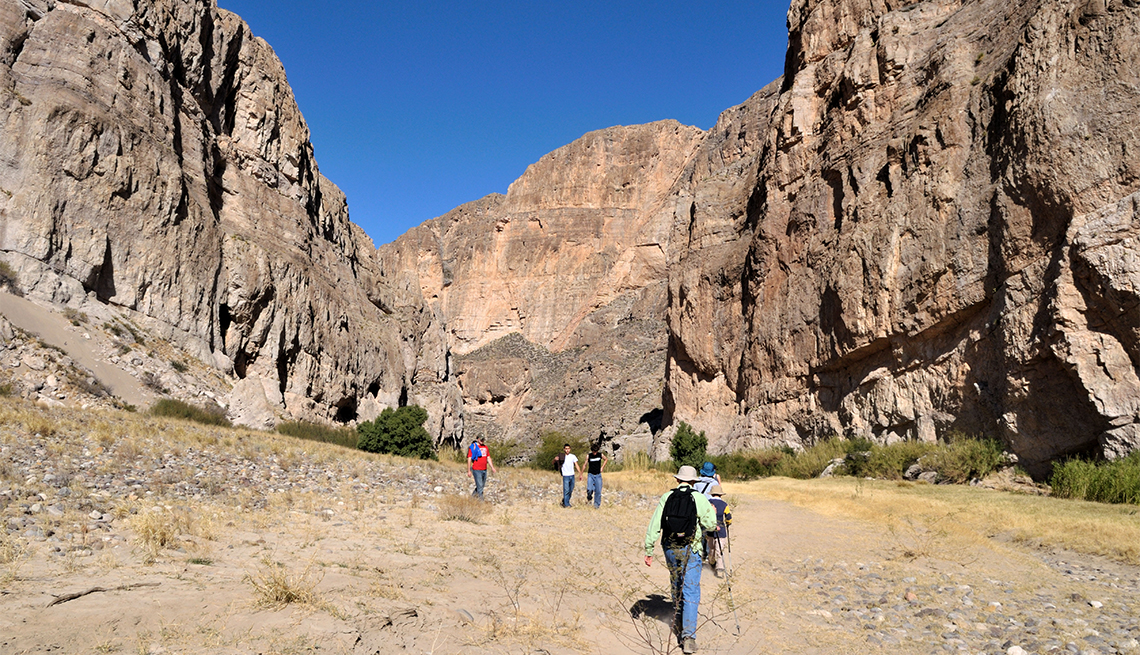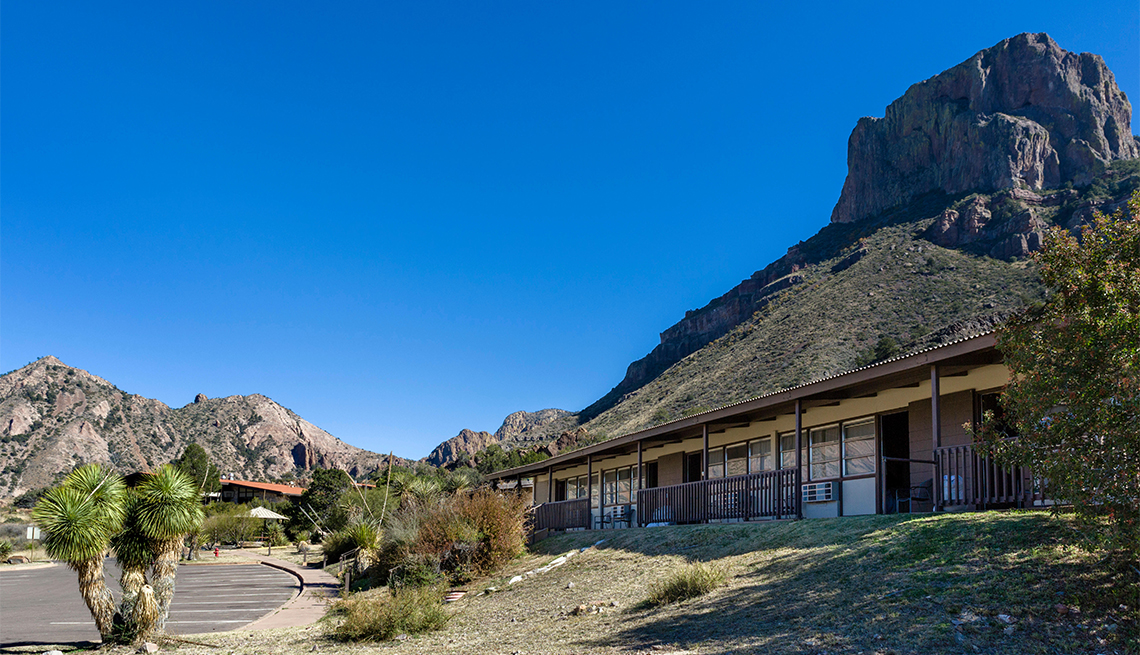AARP'S Guide to Big Bend National Park
A ruggedly beautiful, remote desert landscape along the Rio Grande in West Texas
At first glance, the spiky, cacti-studded expanses of Big Bend National Park might seem barren and desolate. But look closely at the life that grows in this harsh but picturesque environment, dip a toe in the natural hot springs along the Rio Grande, hike into a steep-walled canyon or wander a mountain ridge, and you'll discover beauty far beyond that prickly exterior.
This vast and remote park, which gets its name from the bend created by the river's dramatic switch from a southeastern flow to a northeastern one, covers a sprawling 801,163 acres in far West Texas, along the Mexican border. Here, explore the Chihuahuan Desert, where the native vegetation seems intent on stabbing you in the shin, or climb into the forested “sky islands” of the Chisos Mountains for panoramic views much like peering out an airplane window. It's a rugged terrain in which black bears, deer, mountain lions and tarantulas all scratch out a hardscrabble existence.
All this ruggedness may sound a bit intimidating, but don't let that deter you from visiting this sparsely populated corner of Texas. Be among the nearly 500,000 people who visit the park annually and you'll feel like you've stepped into the Old West when you see the vistas, with layers of mountains and rock formations, including one called Mule Ears, whose twin peaks look like a pair of long, furry equine ears. You'll be in the company of plenty of others ages 50-plus, says interpretive ranger Adam Prato, who adds, “They've got diverse abilities and interests, and participate in just about anything we have to offer."
COVID-19 update
Some facilities, such as visitor centers, are closed due to coronavirus-related restrictions (there are outdoor ranger kiosks set up for visitor assistance). Indoors, group sizes are limited to either 12 people or a single household, and tour buses are not allowed in the park. The park’s Boquillas Port of Entry remains closed (due to the border closure between the U.S. and Mexico). Everyone, regardless of vaccination status, is required to wear a mask inside national park buildings and on all forms of public transportation. Check the park’s website for the latest information.
Location: Far West Texas
Acreage: 801,163 acres
Highest peak: Emory Peak, at 7,832 feet
Lowest point: Rio Grande Village, at 1,850 feet
Mile of trails: 200
Main attraction: Hiking its trails
Entry fee: $30 per vehicle
Best way to see it: Day hikes
Best time to visit: In the cooler months, between November and April
Plan your trip
It takes some determination to get to BBNP, which lies 220 miles southwest of the nearest commercial airport, in Midland/Odessa. Most visitors drive here, usually heading about 300 miles southeast from El Paso or about 400 miles west from San Antonio.
Park admission is $30 per vehicle for a seven-day pass (free with the National Park Service's annual Senior Pass). Access is from one of two entrances — Persimmon Gap on the north side, via U.S. Highway 385 from Marathon; or Maverick Junction on the west, via Texas State Highway 118 through Study Butte. Five visitors centers are scattered throughout the park. If you're a first-timer, stop at park headquarters at Panther Junction, in the center of the roughly wedge-shaped park, for an orientation movie that gives a good overview of what you might see during your visit. Get the lay of the land by studying a three-dimensional model of the park's geographic features, and pick up helpful guidebooks and history books at the bookstore. A 50-yard, wheelchair-accessible nature path just outside the center identifies plants, such as prickly pear, you'll see in the Chihuahuan Desert. Keep an eye out for a desert cottontail rabbit or roadrunner as you stroll the path.
Additional exhibits are found at the Chisos Basin Visitors Center, where you can check a board to pinpoint the latest bear and mountain lion sightings. (Visitors most often spot black bears in the park's higher elevations, and they occasionally see mountain lions, which generally avoid humans, along park roadways after dusk.) In 2019 a fire swept through the collection of historic structures in the old farming community and military outpost of Castolon, near Santa Elena Canyon on the park's west side, forcing park officials to relocate the visitors center there to temporary quarters. Still, it's worth stopping here to see an exhibit detailing rural life in the park a century ago.
It gets hot in this corner of Texas — daytime temperatures can hover around 100 degrees from May to September (with nightly lows in the 60s and 70s). Avoid the searing heat by visiting between November and April; there might be an occasional snowfall in the mountains, but more often it's sunny and mild, with high temperatures in the 60s and 70s during the day and nighttime temperatures mainly in the 30s and 40s. Peak crowds arrive over Thanksgiving, Christmas, New Year's Day and Spring Break, when campgrounds fill and lodge reservations are hard to come by. With so much room to roam, though, it doesn't feel crowded except in high traffic areas such as the Chisos Mountain Basin in the park's center and on popular hiking routes, including the Lost Mines and Window View trails.
Make sure you pack plenty of water before you head out, and if you go hiking, wear comfortable footwear with soles that will grip slippery rock and gravel. Bring a hat and sunscreen and wear lightweight, light-colored clothing, but you'll want a jacket for cool winter evenings.
Restrooms are located at visitors centers and campgrounds; vault toilets are available at Boquillas Canyon, Dugout Wells, the Fossil Discovery Exhibit, the Hot Springs area and Santa Elena Canyon. Cell phone service is spotty, but free Wi-Fi is available at the Panther Junction Visitor Center, the Chisos Mountain Lodge and the Rio Grande Village store.
AARP Membership -Join AARP for just $12 for your first year when you enroll in automatic renewal
Join today and save 25% off the standard annual rate. Get instant access to discounts, programs, services, and the information you need to benefit every area of your life.
Where to stay and eat
Staying in BBNP will save you driving time in this vast, spread-out region and put you next to trailheads for some of the park's best hikes, but you won't be basking in luxury.
Book well in advance at the park's only hotel, the Chisos Mountain Lodge in the basin. “Basic” best describes its 66 rooms (some wheelchair-accessible), though certainly not the stunning views. In the evening you'll want to relax outside your room, watching the sun shift over Casa Grande, a flat-top mountain rising more than 7,000 feet above sea level, and set beneath the Window, a V-shaped notch in the surrounding mountains. As you do, you may see one of the bristly, piglike javelinas that roam the area.
For accommodations with a little more character, settle into one of the lodge's five stone cottages — built by the Civilian Conservation Corps in 1941 — nestled among the juniper, oak and pinon trees and cacti. From your back porch, take in picture-perfect views of the Window. You might spot a kangaroo rat or two hopping by, too.
At dinner, get a good taste of Texas classics — chicken-fried steak with cream gravy, ribeye steaks and the like — in the lodge's restaurant. From its perch atop a hill, peer out a wall of windows at the surrounding rocky mountains and scrub-covered slopes. The restaurant also serves a full breakfast and packs to-go picnic lunches for park explorers.
The nearby Basin Convenience Store also stocks picnic staples. For the nearest restaurants outside the park, you'll need to drive to Terlingua, 26 miles west of park headquarters.
Pitching a tent in the park will get you even more in touch with the Chihuahuan Desert, which covers more than 200,000 square miles and stretches into nearby Mexico. Choose from three developed campgrounds for tents and campers. Rio Grande Village, not far from the river on the park's east side, lies in a grove of acacia and cottonwood trees. It has campsites with full hookups — the only ones in the park — and 75 sites for tents and campers without hookups. The 60 spots at the Chisos Basin Campground are tucked into the Chisos Mountains, a short hike from the park lodge and the convenience store, which sells camping essentials. In the park's southwest corner, close to Santa Elena Canyon, you'll find 24 sites at the first-come, first-served Cottonwood Campground, which sits in the shade of the facility's namesake trees. All three campgrounds have restrooms, flush toilets and drinking water, but the only shower and laundry facilities are located at the Rio Grande Village store next to the Rio Grande Village campground.
Hard-core outdoors lovers might favor drive-to primitive camping amid cacti and canyons in the desert.
Campground permits cost $16 per night ($8 with a senior or access pass); backcountry permits are $10 ($5 with a senior or access pass). Make campground reservations in advance at recreation.gov.
Things to do
BBNP awes visitors with a wide range of exhilarating activities. Here are six not-to-miss experiences that showcase this untamed park's beauty and appeal.
Hit the trails. Hiking is the park's premier activity, with about 200 miles of trails varying from easy to quad-busting.
Make sure you squeeze in an hour one evening to watch the sun sink in the sky from one of the park's most iconic spots. The 0.3-mile, wheelchair-accessible Window View Trail in the Chisos Mountain Basin serves up gaudy sunset views through a notch in the mountains. “It's a spectacular view, and there's also some good birding there,” says Prato.
On the park's east side, a 2-mile gravel road leads to the trailhead at the Hot Springs Historic District. From there, it's an easy walk to the ruins of an old bathhouse and rough pictographs painted on a cliff wall behind a crumbling old resort where travelers relaxed in the early 1900s. Walk another quarter-mile to a pool of hot spring–fed water on the Rio Grande's edge for a dip in the 105-degree tub — assuming you don't mind muddy water. For more hiking after your soak, venture along a 1-mile loop up a rocky bluff before making your way back to the parking area.
On the park's west side, the 1.7-mile Santa Elena Canyon Trail leads across Terlingua Creek, up a series of paved steps, along a rocky ledge and back down to the Rio Grande, where massive cliffs on both sides of the river give the impression of a huge theater curtain about to sweep shut. The towering stone walls make a good sounding board if you're into echoes.
More challenging trails await back at the Chisos Mountain Basin. For an all-day adventure, get an early start and head up the South Rim Trail, a 12-mile route with 2,000 feet of elevation gain. If you're feeling superambitious, add the 1-mile spur up to Emory Peak, the park's highest point. Be prepared: For the last 100 feet, you'll be scrambling over rocks and exposed to sheer drop-offs.
Take a drive. If hiking's not for you, go for a scenic spin in your car. Paved roads connect the park's major attractions — Santa Elena Canyon, the Chisos Mountain Basin and Rio Grande Village. Unimproved dirt roads lead to other points of interest; a high clearance vehicle is helpful but not necessary.
"One of the best routes to take to get a feel for the park is the Ross Maxwell Scenic Drive,” says Prato. “You can fill a day just driving along it, stopping at overlooks and going down to Santa Elena Canyon and back."
Along the 30-mile route, which twists and turns from a point 10 miles west of park headquarters to the canyon, you'll be pulling off plenty to take in the sites and geology. Two stops you're sure to like: At the old Sam Nail Ranch, sit quietly on a bench near a windmill that still pumps water and observe the abundant birdlife it attracts, from green-tailed towhees to painted buntings. At Tuff Canyon, marvel at a gorge carved out of soft volcanic rock from two easy-to-access viewing platforms. If you're game, walk down into the narrow canyon, admiring its chalky walls and gnarled rock formations on an easy 1-mile hike.
Prefer to leave the driving to someone else? Big Bend Overland Tours offers four- to eight-hour excursions that deliver park highlights and hidden vistas. Just you and your party, no others, are shuttled around in the comfort of an air-conditioned, four-wheel-drive vehicle.
Go birding. More than 450 bird species have been seen in BBNP's forested canyons, open desert, river corridor and woodlands. A good viewing spot: The 0.75-mile nature trail at Rio Grande Village winds along a marsh with such river dwellers as egrets and herons. “The park is known for having a lot of different species because we're in an area of overlapping ranges of western and eastern bird species of North America, and the northern range of birds from the tropics,” says Prato.
Get a history lesson. Learn about the park's prehistory at the Fossil Discovery Exhibit on the Persimmon Gap Entrance Road, which outlines the last 130 million years of the Big Bend region, dinosaurs and all. “Big Bend has been the site of a lot of big fossil finds — really big species that include Tyrannosaurus rex and Alamosaurus, a long-necked sauropod,” says Prato.
The open-air facility features replicas of the large flying dinosaur called Quetzalcoatlus, and Deinosuchus, a prehistoric alligator with a body as long as a school bus. Kids (overgrown ones, too) can't resist sticking their heads inside the replica's jaws.
Brave the river. BBNP gets its name from the Rio Grande, and some visitors are eager to raft or paddle the river. Fun-packed canoe, kayak and rafting tours suitable even for novices get you out on its café au lait-colored waters. For an easy daytrip, float through Santa Elena Canyon, where the 1,500-foot cliff walls seem to stretch to the sky. Book river outings with Big Bend River Tours, Desert Sports or Far Flung Outdoor Center.
Get a bird's-eye view. Take in Big Bend's canyons and splintered mountains from high in the sky and you'll get a good sense of the powerful geologic forces that molded this region. Rio Aviation's airborne tours carry up to four sightseers in a single-engine Cessna. A former park ranger founded the company and pilots the plane, sharing his firsthand knowledge of the region.
Gateway towns
The nearest towns to BBNP are the quirky little sister communities of Study Butte and Terlingua, 26 miles west of park headquarters. Crews mined quicksilver here in the early 1900s, and today you can wander the ruins of the adobe buildings where the miners once lived in Terlingua's ghost town. Expect the unexpected — you might meet a cowboy on a horse at an outdoor bar, see a metal sculpture of a giant wasp or stumble upon an impromptu Hula-Hoop competition.
Even if you're not staying in Terlingua or Study Butte, spend an evening in Terlingua. Locals gather nightly to sing and strum guitars on the porch of the Terlingua Trading Company & Book Store, which sells a well-curated selection of Texas-themed books. The neighboring Starlight Theatre Restaurant and Saloon, where miners once whiled away West Texas nights watching movies, serves up some of that famous Terlingua chili, as well as tequila-marinated quail and chicken-fried wild boar, along with live music.
The lodging options are unique. La Posada Milagro rents comfortable rooms built from crumbling ghost town ruins, and serves tacos and java at its popular coffee shop. At Basecamp Terlingua, you can stay in a luxury tepee outfitted with lights and an evaporative cooler.
Some choose to visit the park from Marathon, an easy 68 miles north of park headquarters. You won't find so much as a single traffic light, but you can hang your hat at the 93-year-old Gage Hotel. Prolific West Texas architect Henry Trost designed this hotel and three more in other railroad towns in the region between 1927 and 1930. Listen to the chugging of passing trains as you sip a margarita under the mounted head of a rare white buffalo in the hotel's bar or stroll among native cacti in the gardens across the street.
En route
For a good introduction to West Texas, stop at the Museum of the Big Bend at Sul Ross State University in Alpine, 99 miles north of park headquarters. You'll get good insights to life in the Big Bend region through exhibits that detail BBNP's creation and recount the important roles the mining and railroad industries played in the area through the years.
If you're traveling through the artsy enclave of Marfa, 124 miles northwest of park headquarters, stop to contemplate larger-than-life installations by minimalist artist Donald Judd, a New Yorker drawn here in the 1970s by the desert landscape and, frankly, the lack of other people. Judd's large aluminum sculptures populate artillery sheds at the old Fort D.A. Russell; huge concrete works are visible outside the windows.
From Marfa, drive 60 miles south to Presidio, then head southeast on Farm to Market Road 170 toward Terlingua. Known to locals as the River Road, this 62-mile stretch of scenic highway, with pullouts and overlooks down to the glinting Rio Grande, will make you think you're motoring alongside a slightly smaller version of Arizona's Grand Canyon.
- |
- Photos
Editor's note: This article was originally published on November 3, 2020. It's been updated to reflect recent COVID-19 developments.




